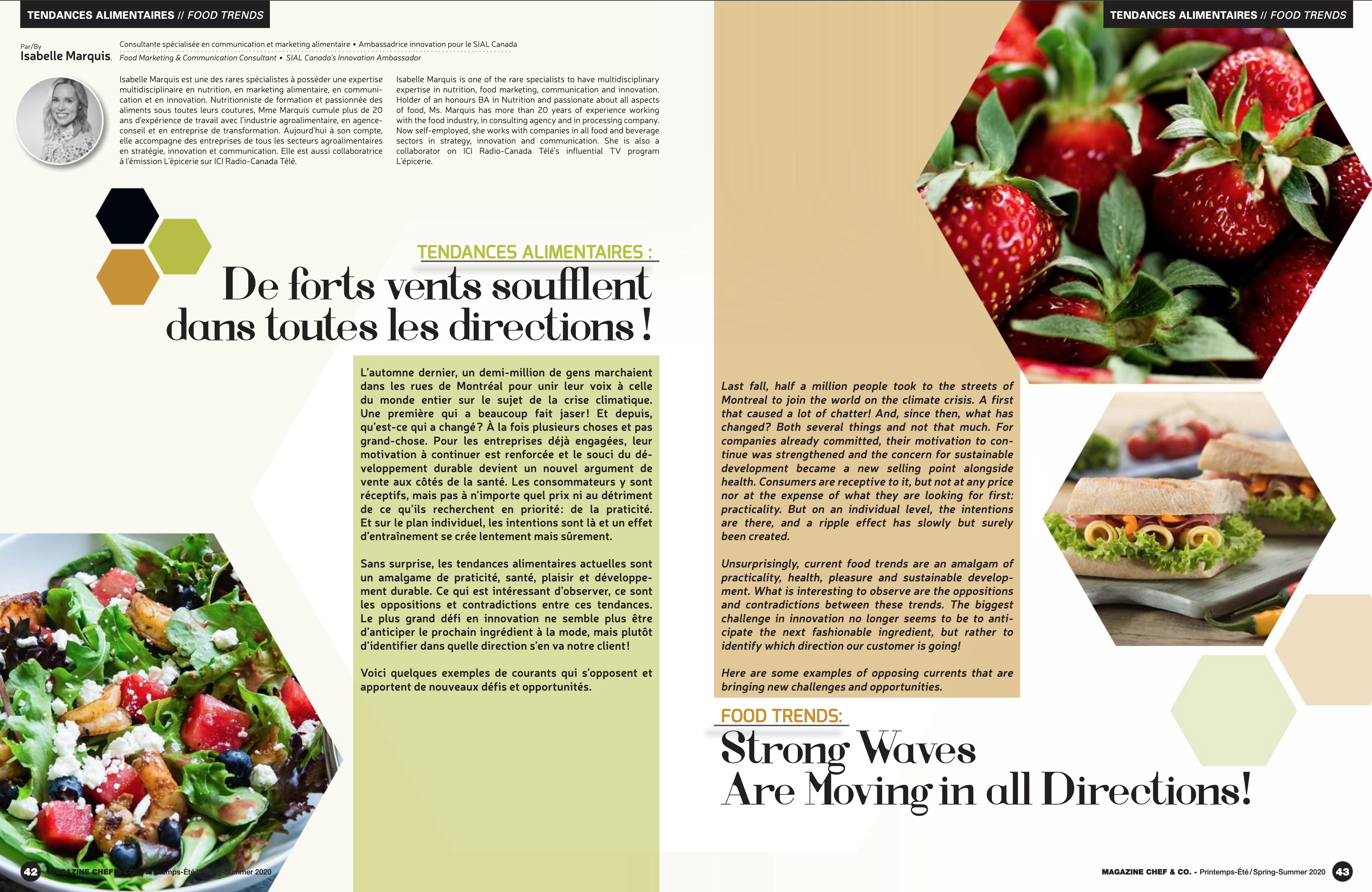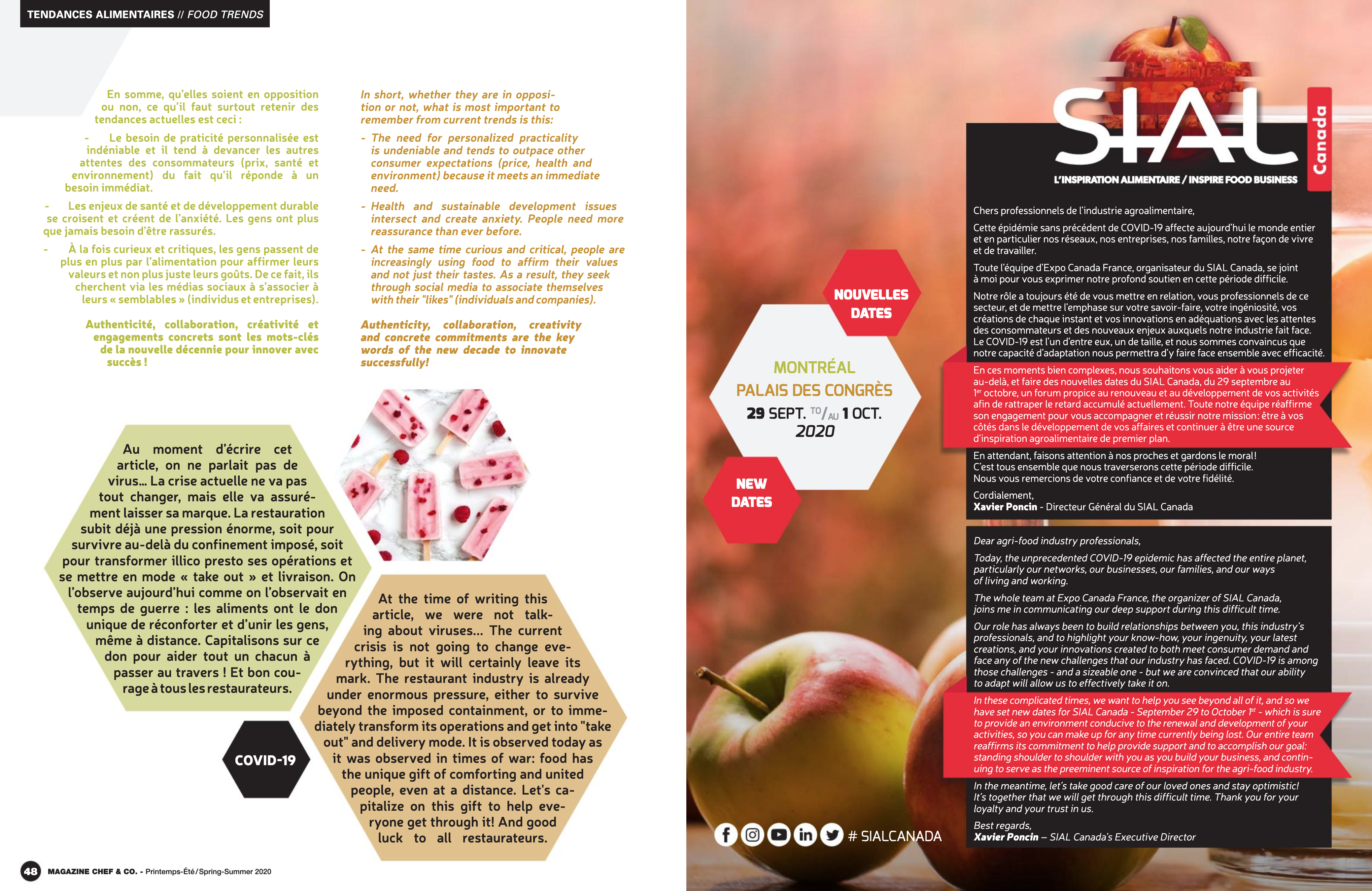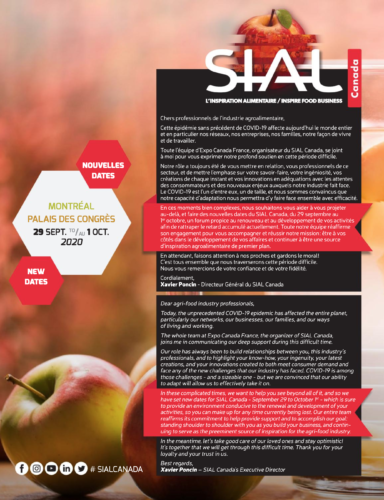FOOD TRENDS FILE: Strong Waves Are Moving in all Directions!
BY ISABELLE MARQUIS
Food Marketing & Communication Consultant • SIAL Canada’s Innovation Ambassador
Isabelle Marquis is one of the rare specialists to have multidisciplinary expertise in nutrition, food marketing, communication and innovation. Holder of an honours BA in Nutrition and passionate about all aspects of food, Ms. Marquis has more than 20 years of experience working with the food industry, in consulting agency and in processing company. Now self-employed, she works with companies in all food and beverage sectors in strategy, innovation and communication. She is also a collaborator on ICI Radio-Canada Télé’s influential TV program L’épicerie.
Last fall, half a million people took to the streets of Montreal to join the world on the climate crisis. A first that caused a lot of chatter! And, since then, what has changed? Both several things and not that much. For companies already committed, their motivation to con-tinue was strengthened and the concern for sustainable development became a new selling point alongside health. Consumers are receptive to it, but not at any price nor at the expense of what they are looking for first: practicality. But on an individual level, the intentions are there, and a ripple effect has slowly but surely been created.
Unsurprisingly, current food trends are an amalgam of practicality, health, pleasure and sustainable development. What is interesting to observe are the oppositions and contradictions between these trends. The biggest challenge in innovation no longer seems to be to anti-cipate the next fashionable ingredient, but rather to identify which direction our customer is going!
Here are some examples of opposing currents that are bringing new challenges and opportunities.
NATURALITY, SIMPLICITY AND RETURN TO THE ROOTS VS “TECHNOLOGICAL” FOODS
Consumers have been looking for and demanding more natural and healthy foods for several years now. Exit chemical additives and other ingredients that cannot be pronounced and that are not bought at the grocery store. This trend also includes the contagious craze for urban gardens, public market visits and the purchase of organic baskets, as well as the return of bulk supply. In short, we want to simplify our diet and reconnect with our food. And the current awareness of the links between climate issues and our eating habits only adds one more argument to convince us to take action.
At the same time, the development of new technologies has never stopped progressing, so we are being offered more and more functional foods with multiple benefits. The climate crisis obviously serves as an extraordinary springboard for plant-based meat and dairy substitutes: products that may help save our planet but are not all as natural as we think. All these technological innovations have one thing in common: they rely on effective marketing that touches on several sensitive nerves of consumers.
Note that behind these seemingly very different trends lie similar needs: taking care of one’s health and protecting/respecting the environment. However, the deep motivations are very different. On the one hand, we want to regain control and get back to basics. On the other, we are looking for shortcuts to the promised benefits.
*** According to a U.S. study conducted last December, people’s primary motivation to buy plant-based meat alternatives is simply curiosity!
LESS COOKING VS EXPERIMENTING AND DISCOVERING
The options for spending less time planning and preparing meals have never been so great! The restaurant and retail market are undergoing a complete transformation to meet the practicality needs of consumers. This trend is so strong that it leads me to believe that people’s lifestyles and life context have more influence on their food choices than their health and environmental concerns combined… However, these concerns are there and companies that manage to offer choices that respond to them in addition to being practical have the advantage.
You might think that this remoteness from our stoves is accompanied by a lack of interest in cooking and experimenting, but this is not quite the case: cooking TV shows, blogs and cookbooks are still as popular. Social media also confirms people’s interest in culinary discoveries: 44% of 18-34-year-olds (the biggest users of social media) say they share content about what they eat and 87% say they discover new things.
Basically, meal solutions have the potential to respond to much more than the need for practicality: they can also stimulate curiosity and the desire for culinary discoveries among people of all ages, or even give them the taste to cook.
OVEREXPLOITATION VS SUSTAINABLE VALORIZATION OF NATURAL RESOURCES
It is a fact that intensive agriculture and livestock are over-exploiting nature at a rate that exceeds its ability to adapt and renew itself. Consumers know this, but know only the tip of the iceberg, so they shift responsibility back to the industry while continuing to demand more than perfect food, variety and freshness from it. There is a lot of educational work to be done to change attitudes.
One of the concrete solutions that are accessible to all is well summed up in this quote from Brazilian chef Alex Atala: “Knowing how to use the complete food is also part of learning when you think about the cuisine of the future.” How to make a less noble meat cut or a deformed food attractive? We need the chefs to get there! Ditto for insects and for everything we have learned to despise.
In short, whether they are in opposition or not, what is most important to remember from current trends is this:
– The need for personalized practicality is undeniable and tends to outpace other consumer expectations (price, health and environment) because it meets an immediate need.
– Health and sustainable development issues intersect and create anxiety. People need more reassurance than ever before.
– At the same time curious and critical, people are increasingly using food to affirm their values and not just their tastes. As a result, they seek through social media to associate themselves with their “likes” (individuals and companies).
Authenticity, collaboration, creativity and concrete commitments are the key words of the new decade to innovate successfully!
At the time of writing this article, we were not talking about viruses… The current crisis is not going to change everything, but it will certainly leave its mark. The restaurant industry is already under enormous pressure, either to survive beyond the imposed containment, or to immediately transform its operations and get into “take out” and delivery mode. It is observed today as it was observed in times of war: food has the unique gift of comforting and united people, even at a distance. Let’s capitalize on this gift to help everyone get through it! And good luck to all restaurateurs.





